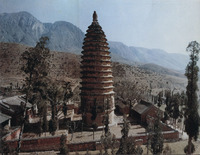Songyue si
| dc.coverage.spatial | Site: Dengfang (China) | en_US |
| dc.coverage.temporal | creation date: 519 CE-525 CE | en_US |
| dc.creator | unknown (Chinese) | en_US |
| dc.date | 519 CE-525 CE | en_US |
| dc.date.accessioned | 2006-11-15T21:35:12Z | |
| dc.date.available | 2006-11-15T21:35:12Z | |
| dc.date.issued | 519-525 | en_US |
| dc.identifier | 105725 | en_US |
| dc.identifier.uri | http://hdl.handle.net/1721.3/13728 | en_US |
| dc.description | The Songyue Temple (Songyue si), at the foot of Mt Taishi in the Mt Song region, was founded under the Northern Wei. Originally an imperial residence, it was converted to a Buddhist temple in the 520s. It has one of the oldest brick pagodas in China, dating to the Zhengguang reign period (ad 519–25). The pagoda (see China, fig. 17) is 12-sided and multi-storey; the main upper storey has windows on each side with lotus arches. The ornamental brickwork is unusual and thought to be influenced by the contemporary architectural style of Gupta India (4th–5th centuries ad). The other remaining buildings in the temple are of later date. | en_US |
| dc.description | general view | en_US |
| dc.format.extent | height: 41 m | en_US |
| dc.format.medium | brick | en_US |
| dc.format.medium | wood (plant material) | en_US |
| dc.relation.ispartof | 127308 | en_US |
| dc.rights | (c)New China News Agency, Henan Branch | en_US |
| dc.subject | Brickwork | en_US |
| dc.subject | Buddhism | en_US |
| dc.subject | Pagodas | en_US |
| dc.subject | Octagonal | en_US |
| dc.subject | Architecture, Buddhist | en_US |
| dc.subject | Temples, Buddhist | en_US |
| dc.subject | Architecture, Chinese | en_US |
| dc.title | Songyue si | en_US |
| dc.title.alternative | Songyue Temple | en_US |
| dc.type | Image | en_US |
| dc.rights.access | All rights reserved | en_US |
| vra.culturalContext | Chinese | en_US |
| vra.technique | construction | en_US |
| vra.worktype | Temple | en_US |
| vra.worktype | Pagoda (Building) | en_US |
| dc.contributor.display | unknown (Chinese) | en_US |


